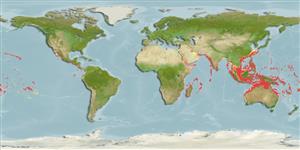Common names from other countries
Environment: milieu / climate zone / depth range / distribution range
Ecologia
marinhas associadas(os) a recifes; intervalo de profundidade 3 - 150 m (Ref. 9281). Tropical; 30°N - 35°S, 29°E - 70°W
Indo-Pacific: in tropical waters, from South Africa to Hawaii and Easter Island, north to southern Japan and south to Lord Howe Island. Eastern Pacific: Revillagigedo, Clipperton and Cocos islands (Ref. 9281).
Tamanho / Peso / Idade
Maturity: Lm ? range ? - ? cm
Max length : 51.0 cm NG macho/indeterminado; (Ref. 89467); peso máx. publicado: 1.8 kg (Ref. 89467)
Espinhos dorsais (total) : 0; Raios dorsais (total) : 96 - 104; Espinhos anais: 0; Raios anais : 74 - 81. Eyed side with dark margined light colored spots and numerous scattered small dark spots; normally with 3 dark blotches or spots on lateral line; dorsal and anal fins with longitudinal row of widely-spaced dark spots; pectorals of the eyed side with dark crossbars (Ref. 4417).
Inhabit sandy bottoms of coastal coral reefs (Ref. 5213, 48637), generally in shallow water (Ref. 9281). Benthic (Ref. 58302). Hunt mostly at night, but also active during the day. Often crawling over low rocky reef (Ref. 48637). Occasionally rest on bare rock (Ref. 1602). Feed on fishes, crabs and shrimps. Collected by divers (Ref. 9824).
Ciclo de vida ou comportamento de acasalamento
Maturities | Reprodução | Spawnings | Egg(s) | Fecundities | Larvas
Hensley, D.A., 1986. Bothidae. p. 854-863. In M.M. Smith and P.C. Heemstra (eds.) Smiths' sea fishes. Springer-Verlag, Berlin. (Ref. 4417)
Status na Lista Vermelha da UICN (Ref. 130435)
CITES (Ref. 128078)
Not Evaluated
Ameaça para os humanos
Harmless
Uso pelos humanos
Pescarias: espécies comerciais; Aquário: Espécies comerciais
Ferramentas
Relatórios especiais
Baixar XML
Fontes da internet
Estimates based on models
Preferred temperature (Ref.
115969): 23.8 - 29, mean 27.7 (based on 1590 cells).
Índice de diversidade filogenética (Ref.
82804): PD
50 = 0.5000 [Uniqueness, from 0.5 = low to 2.0 = high].
Bayesian length-weight: a=0.01000 (0.00426 - 0.02347), b=3.07 (2.89 - 3.25), in cm Total Length, based on LWR estimates for this Genus-body shape (Ref.
93245).
Nível Trófico (Ref.
69278): 4.4 ±0.0 se; based on diet studies.
Resiliência (Ref.
120179): Baixo, tempo mínimo de duplicação da população 4,5 - 14 anos (Preliminary K or Fecundity.).
Fishing Vulnerability (Ref.
59153): Low vulnerability (18 of 100).
